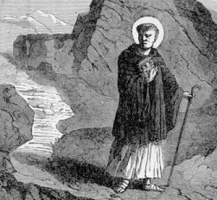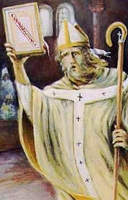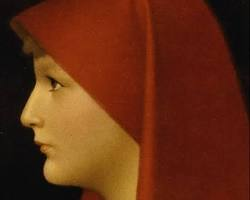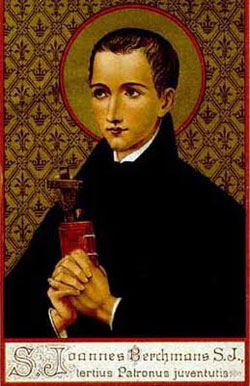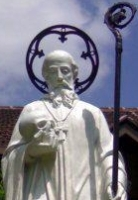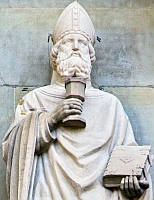Saint Laverius
Also known as
Laberio, Laverio, Lavierio, Laviero
Additional Memorial
• 17 November on some calendars in southern Italy
• 7 September (Tito, Italy)
Profile
Son of Achille, Laverius was raised in a pagan family. Served as a soldier in the imperial Roman army. A convert to Christianity, he began preaching in the streets of Teggiano, Italy. By order of the prefect Agrippa, Laverius was arrested, tortured, put on display for public abuse and ridicule, and ordered to make sacrifice to pagan gods; he refused. He was then thrown to wild animals in the amphitheatre, but instead of attacking him, they knelt in front of him. Laverius was thrown back into this cell, but an angel freed him during the night and ordered him to travel to Grumentum (modern Grumento Nova, Italy). He arrived on 15 August 312 and began immediately to preach and to baptize converts. Agrippa sent soldiers after him. Laverius was captured, flogged, and when he would not stop preaching Christ even while being beaten, he was executed. Martyr.
Born
3rd century Acerenza, Ripacandida or Teggiano (records vary), Italy
Died
• beheaded on 17 November 312 at the confluence of the Agri and Sciaura Rivers outside Grumentum (modern Grumento Nova, Italy)
• his soul was seen flying from the body into heaven
• his body was abandoned by the soldiers where it fell, but a Roman matron came later and gave him a Christian burial
• a chapel devoted to him was built at the execution site
• relics later dis-interred and dispersed to prevent their loss to invading barbarians
• relics later further dispersed to prevent their loss to invading Saracens
• some relics destroyed c.1427 in the sack of Satriano, Italy
• an arm bone made it to Tito, Italy by 1465
• last relic stolen in Tito in December 1968
Blessed Bernardine of Fossa
Also known as
• Bernardine d'Amici
• Bernardine of Aquila
• Bernardine of Aquilanus
• Fra Bernardino of Fossa
• Giovanni Amici
Additional Memorial
7 November (Franciscans)
Profile
Born to the nobility, member of the Amici family. An excellent student, he was educated at Aquila, Italy. Obtained doctorates in civil law and canon law at Perugia, Italy. Joined the Franciscan Friars Minor on 12 March 1445 in Perugia, taking the name Giovanni Bernardino, and receiving the habit from Saint James of the Marches. Held assorted administrative posts at several Franciscan monasteries in the regions of Umbria and Abruzzi in Italy. Evangelist throughout Italy, Dalmatia and Serigonia. Provincial of his Order in Italy from 1454 to 1460; provincial in Dalmatia and Bosnia from 1464 to 1467; attorney general to the Roman Curia from 1467 to 1469; provincial in Italy from 1472 to 1475. Twice chosen bishop of Aquila, and twice refused the see, citing his inadequacy to the position. Noted historian and ascetical writer, and many of his sermons have survived to today; wrote the first biography of Saint Bernardine of Siena.
Born
1420 in Fossa, Aquila, Italy as Giovanni Amici
Died
27 November 1503 in the Franciscan convent in L'Aquila, Italy of natural causes
Beatified
26 March 1828 by Pope Leo XII (cultus confirmation)
Saint Virgilius of Salzburg
Also known as
• Apostle of Carinthia
• Fergal, Fearghal, Ferghil, Vergil, Virgiel, Virgil
Profile
Benedictine monk. Pilgrim to the Holy Land in 743, and on the way home he stopped in Bavaria - and stayed. Worked with Saint Rupert of Salzburg. Abbot of Saint Peter's monastery in Salzburg, Austria; one of his monks was Saint Modestus. Bishop of Salzburg in 765, ordained by Duke Odilo. Saint Boniface twice accused him of heresy because of his scientific ideas (including a round earth), but this reflected some friction between the style and people of Roman and Celtic origins, and Virgilius was always cleared of the charges. He rebuilt the cathedral of Salzburg. Sent missionary priests to Carinthia, Austria.
Born
8th century Ireland
Died
• 784 at Salzburg, Austria of natural causes
• relics in the altar of the cathdral of Salzburg, Austria
Canonized
10 June 1233 by Pope Gregory IX
Saint Josaphat
Also known as
Ioasaph, Iasaph, Joasaph, Yudasaf
Profile
With Saint Barlaam, one of the protagonists in a Christianized retelling of the story of Siddhartha Buddha that was popular in the Middle Ages.
Many people in India were converted by Thomas the Apostle. Astrologers foretold that the son of King Abenner would one day become a Christian. To prevent this, Abenner began persecuting the Church, and had his son placed under house arrest. In spite of these precautions, Barlaam, a hermit of Senaar, met him, and converted him to the Faith. Abenner tried to pervert Josaphat, but failed, and shared the government with him. Abenner himself later became a Christian, abdicated the throne, and became a hermit. Josaphat governed for a time, then abdicated, too. He travelled to the desert, found Barlaam, and spent his remaining years as a holy hermit. Years after their deaths, the bodies Josaphat and Barlaam were brought to India; their joint grave became renowned by miracles.
Saint Secundinus of Ireland
Also known as
• Secundinus of Dunsaghlin
• Secundinus of Dunseachlin
• Secundinus of Dunshaughlin
• Seachnal, Seachnall, Sechnall, Secundin
Additional Memorial
6 December (joint celebration of the missionary work of Secundinus and Saint Auxilius)
Profile
Migrated to Ireland in 439 with Saint Auxilius and Saint Iserninus to help Saint Patrick evangelize the country; Secundinus preached in the north and east. There are many conflicting documents about him - whether he was a priest or bishop when he arrived, if he had been there before, etc. He apparently served as acting bishop of Armagh, Ireland when Patrick went to Rome. Founded a church and served as first bishop of Dunshaughlin, Meath, Ireland. Wrote the earliest poem of the Irish Church, an alphabetical hymn in honour of Saint Patrick.
Born
c.375 in Gaul (modern France, possibly the area of Auxerre
Died
27 November 447 of natural causes
Saint Maximus of Riez
Profile
Raised in a Christian home, in his youth he began to live as a hermit there. Monk at the monastery founded by Saint Honoratius in Lerins, France. Abbot in 426; Saint Sidonius wrote about the revitalization of the monastic life under Maximus' leadership. He became known as a miracle worker and his reputation for wisdom and holiness spread to the point that he fled to live as a forest hermit. Reluctant bishop of Riez, Provence in 434, consecrated by Saint Hilary who had tracked him down at his hermitage. Lived as much as a monk as his vocation as bishop would allow. Attended synods at Riez in 439, Orange in 441, and Arles in 454. One of the most influential bishops in the Gaul of his day.
Born
in Decom, Provence (modern Châteauredon, France)
Died
• 460 of natural causes
• interred in Riez, France
Blessed Bronislao Kostkowski
Also known as
Bronislas, Bronislaw
Additional Memorial
12 June as one of the 108 Martyrs of World War II
Profile
Seminarian in the diocese of Wlaoclawek, Poland. Arrested by Nazi officials in 1939 along with his seminary teachers, and lodged in the concentration camp at Dachau, Bavaria, Germany, which had a special section for Catholic clergy. He was offered his freedom if he would renounce his calling to the priesthood; he declined. Martyr.
Born
11 March 1915 in Slupsk, Zachodniopomorskie, Poland
Died
starved to death on 27 November 1942 the concentration camp at Dachau, Oberbayern, Germany
Beatified
13 June 1999 by Pope John Paul II
Saint Fergus the Pict
Also known as
• Fergus Cruithneach
• Fergustian, Fergustus
Profile
May have studied in both Scotland and Ireland. Priest. Travelling bishop in Ireland. Evangelist in the counties of Perth and Caithness in Scotland. Founded churches dedicated to Saint Patrick at Strageath, Blackford, and Dolpatrick in Perthshire; Wick and Halkirk, in Caithnessshire; and Lungley (now Saint Fergus), in Aberdeenshire. Settled in Glamis in c.710. Attended a synod in Rome, Italy in 721 which condemned sorcery and irregular marriages.
Born
Pictish Scotland
Died
• c.730 at Glamis, Forfarshire, Scotland of natural causes
• head transferred to the Scone Abbey
Saint Gulstan
Also known as
Constans, Goustan, Gulstanus, Gunstan, Gustan
Profile
Sailor. Hermit. Benedictine monk and then abbot at the abbey of Saint Gildas of Rhuys, Brittany under Saint Felix. Hermit on Hoëdic Island off the southern coast of Brittany.
Born
Ouessant, Brittany, France
Died
• c.1010 of natural causes
• buried at the church of St-Gildas-de-Rhuys in Brittany, France
Saint James Intercisus
புனித_ஜேம்ஸ்_இன்டர்சிசுஸ் (ஐந்தாம் நூற்றாண்டு)
நவம்பர் 27
இவர் (#StJamesIntercisus) பெர்சியாவை ஆண்ட முதலாம் யஸ்டிகெர்ட் (Yezdigerd I 399-420) என்பவருடைய படையில் படை வீரராகப் பணியாற்றி வந்தார்.
அடிப்படையில் இவர் கிறிஸ்தவராக இருந்தாலும், உயிருக்குப் பயந்து கிறிஸ்தவ அடையாளத்தை மறைத்தே வந்தார். இச்செய்தி எப்படியோ இவருடைய தாயாருக்குத் தெரியவர, அவர் இவரை ஒரு கடிதம் மூலம் கடிந்துகொண்டார்.
இதன்பிறகு இவர் தன் தவற்றை உணர்ந்து, கிறிஸ்தவ நம்பிக்கை மிகத் துணிச்சலாக அறிவித்தார். இச்செய்தி அப்பொழுது பெர்சியாவை ஆண்ட பஹ்ராம் என்ற மன்னனுக்குத் தெரியவர, அவன் இவரை 28 துண்டுகளாக வெட்டிக் கொன்று போட்டான்.
Also known as
Jakob Intercisus
Profile
Military officer and courtier to King Jezdigerd I. During Jezdigerd's persecution of Christians, James apostacized. Following Jezdigerd's death, he was contacted by family members who had never renounced their faith. James experienced a crisis of faith and conscience, and openly expressed his faith to the new king Bahram. He was condemned, tortured and martyred.
Born
Beth Laphat, Persia
Died
slowly cut into 28 pieces, finally dying from beheading in 421
Saint Eusician
Also known as
Eusice, Eusicio, Eusizio
Profile
Sixth-century hermit at the foot of Mount Caro in the area of Blois, France living in a small cell protected from the outside world by thorny brush. Coming to believe that such a complete withdrawal from his fellow man to spend a life in prayer was somewhat selfish, Eusician embarked on a mission of doing good works; known as a healer, especially of children and of throat ailments in particular. Saint Gregory of Tours wrote about his reputation for spiritual wisdom.
Died
542 in the area of Blois, France of natural causes
Saint Barlaam
Also known as
Varlaam
Profile
Convert to Christianity in northern India. Hermit. Brought Saint Josaphat to the faith, and then returned to his life as a cave hermit.
Blessed Juan Antonio de Bengoa Larriñaga
Also known as
Daciano
Profile
Professed religious in the Brothers of the Christian Schools (De La Salle Brothers). Martyred in the Spanish Civil War.
Born
17 January 1882 in Dima, Vizcaya, Spain
Died
27 November 1936 in Paracuellos de Jarama, Madrid, Spain
Beatified
13 October 2013 by Pope Francis
Saint Acharius of Tournai
Also known as
• Acharius of Noyon
• Acharius of Luxeuil
• Achaire of...
Profile
Monk at Luxeuil Abbey in Burgundy (in modern France) under the direction of Saint Eustace. Bishop of Noyon-Tournai in 621. Helped the missionary work of Saint Amandus of Maastricht. Worked to have Saint Omen named bishop of Thérouanne.
Died
640 of natural causes
Blessed José Pérez González
Also known as
Ramiro of Sobradillo
Profile
Franciscan Capuchin priest. Martyred in the Spanish Civil War.
Born
5 January 1907 in Sobradillo, Salamanca, Spain
Died
27 November 1936 in Paracuellos de Jarama, Madrid, Spain
Beatified
13 October 2013 by Pope Francis
Saint Severinus the Hermit
Also known as
Severin
Profile
Hermit at and then near Paris, France. Lived in a walled up cell. Spiritual teacher of Saint Cloud.
Died
• c.540 in the Latin Quarter of Paris, France of natural causes
• relics enshrined in the cathedral of Notre Dame
Saint Bilhild
ஆல்ட்முயூன்ஸ்டர் நகர் துறவி பில்ஹில்டிஸ் Bilhildis von Altmünster
பிறப்பு
7 ஆம் நூற்றாண்டு,
பவேரியா
இறப்பு
734,
மைன்ஸ் Mainz, Germany
இவரைப்பற்றிய வரலாறு அதிகம் அறியப்படவில்லை. இவர் இளம் வயதிலேயே திருமணம் செய்யப்பட்டவர் என்று கூறப்படுகின்றது. தூரின் நாட்டு அரசர் முதல் ஹெட்டான் (Hetan I) என்பவர் இவரின் கணவர். பில்ஹில்டிஸ் தன் கணவரையும் அவரின் குடும்ப உறுப்பினர்கள் அனைவரையும் மனந்திருப்பி, கிறிஸ்துவ மறையை பின்பற்றச் செய்தார். என்று சொல்லப்படுகின்றது. பில்ஹில்டிஸின் கணவர் இறந்தபிறகு விதவையான இவர் தன் மாமா பேராயராக இருந்ததால் பல விதங்களிலும் அவருக்கு உதவி செய்துள்ளார்.
பின்னர் ஆல்ட்முயூன்ஸ்டர் சென்று அங்கு ஒரு துறவற மடத்தில் சேர்ந்து பல நாட்கள் கழித்து துறவியானார் என்று கூறப்படுகின்றது. இவர் இறக்கும் வரை மிகப் பக்தியுள்ள சிறந்த துறவியாக வாழ்ந்துள்ளார். இவர் இறந்தபிறகு எங்கு புதைக்கப்பட்டார் என்று கண்டறிய இயலவில்லை.
Also known as
Bilhildis
Profile
Born to the nobility. Married to the Duke of Thuringia. Widow. Founded the convent of Altenmünster in Mainz, Germany.
Born
c.630 near Würzburg, Germany
Died
c.710
Saint Hirenarchus of Sebaste
Also known as
Hirenarkus, Hiernarkus, Hiernarchus
Profile
Pagan who converted while witnessing the faith of the Martyrs of Sebaste during their persecution; he was martyred with them.
Died
c.305 at Sebaste, Armenia
Saint Acacius of Sebaste
Profile
Priest at Sebaste, Armenia. Martyred during the persecutions of Diocletian with Saint Hirenachus and seven female companions whose names have not come down to us.
Died
c.305 at Sebaste, Armenia
Saint Valerian of Aquileia
Profile
Bishop of Aquileia, Italy. Fought for years to eradicate Arianism.
Died
389
Saint Facundus
புனிதர்கள் ஃபகுண்டஸ் மற்றும் பிரிமிடிவஸ்
மறைசாட்சியர்:
பிறப்பு: ----
லியோன், ஸ்பெயின்
இறப்பு: கி. பி. 300
தற்போதைய 'சஹாகுன்' என்ற இடத்திற்கு அருகில், ஸ்பெயின்
ஏற்கும் சமயம்:
ரோமன் கத்தோலிக்க திருச்சபை
கீழ் மரபுவழி திருச்சபை
நினைவுத் திருநாள்: நவம்பர் 27
புனிதர்கள் ஃபகுண்டஸ் மற்றும் பிரிமிடிவஸ் ஆகிய இருவரும் கிறிஸ்தவ மறைசாட்சிகளாகவும் புனிதர்களாகவும் அருட்பொழிவு செய்யப்பட்டவர்களாவர்.
பாரம்பரியப்படி, ஸ்பெயின் நாட்டின் லியோன் (León) பகுதியின் கிறிஸ்தவ பூர்வீக குடிகளாகிய இவர்கள், "சியா" (River Cea) நதிக்கரையில் சித்திரவதை செய்யப்பட்டு தலை துண்டிக்கப்பட்டு கொல்லப்பட்டனர்.
அவர்களது தியாகத்தின் தகவல்களின் அடிப்படையில், அவர்களது தலை துண்டிக்கப்பட்ட வேளையில், அவர்கள் இருவரதும் கழுத்துப் பகுதியில் இருந்து பாலும் இரத்தமும் பீரிட்டதாக கூறப்படுகிறது.
"சஹாகுன்" (Sahagún) நகரைச் சுற்றியுள்ள “பெனடிக்டைன் துறவு மடம்” (Benedictine monastery) இவ்விரு புனிதர்களின் பெயரில் அர்ப்பணிக்கப்பட்டுள்ளது.
Also known as
Facundo
Profile
Martyr. The monastery of Sahagun, Spain, and the town that grew up around it, were named for him.
Born
in Léon, Spain
Died
beheaded c.300 at Sahagun, Spain
Saint Primitivus of Sahagun
Also known as
Primitivo of Sahagun
Profile
Saint Primitivus of Sahagún (Spanish: San Primitivo de Sahagún) was a Christian martyr from León, Spain. He and his companion Saint Facundus were tortured and beheaded during the Roman persecution of Christians in the early 4th century. Their martyrdom is commemorated on November 27 in the Catholic and Eastern Orthodox Churches.
Early Life and Martyrdom
Primitivus was born in León, Spain, in the late 3rd century. He was a Christian from a young age and was known for his piety and zeal for the faith.
During the reign of Emperor Diocletian (284-305 AD), a fierce persecution of Christians was unleashed throughout the Roman Empire. Primitivus and his friend Facundus were arrested for their faith and brought before the Roman governor in León.
When the two refused to renounce their Christianity, they were subjected to various tortures. They were flogged, beaten, and burned, but they remained steadfast in their faith. Finally, they were beheaded on the banks of the Cea River near Sahagún.
Veneration
The bodies of Primitivus and Facundus were buried near the site of their martyrdom. A shrine was later built over their tombs, and they became known as the "Martyrs of Sahagún."
In the 9th century, a Benedictine monastery was founded at Sahagún, and the relics of Primitivus and Facundus were transferred to the monastery church. The monastery became a major pilgrimage center, and the two saints were widely venerated throughout Spain.
Primitivus and Facundus are considered to be patron saints of the town of Sahagún. They are also invoked against persecution and for the strength to endure suffering.
Feast Day
The feast day of Saints Primitivus and Facundus is celebrated on November 27 in the Catholic and Eastern Orthodox Churches.
Saint Siffred of Carpentras
Also known as
Siffrein, Suffredus, Syffroy
Profile
Monk at Lérins Abbey. Bishop of Carpentras, France.
Born
Albano, Italy
Died
c.540
Saint John Angeloptes
Profile
Bishop of Ravenna, Italy in 430. Metropolitan of Aemilia and Flaminia. Once received a vision of an angel who helped him celebrate the Eucharist.
Died
433 of natural causes
Saint John of Pavia
Profile
Ninth-century bishop of Pavia, Italy for 12 years. Noted for his care for the poor, his insistence on clerical discipline, and his work against vice in the general population of his diocese.
Saint Apollinaris of Monte Cassino
Profile
Abbot of Monte Cassino Abbey for eleven years.
Died
828
Saint Gallgo
Profile
Sixth century founder of the Llanallgo monastery in Anglesey, Wales.
Born
Welsh
Martyrs of Antioch
Profile
A group of Christians martyred together for their faith. Little information has survived except for their names - Auxilius, Basileus and Saturninus.
Martyrs of Nagasaki
Profile
A group of eleven Christians martyred together for their faith during a period of official persecution in Japan. They are
• Alexius Nakamura
• Antonius Kimura
• Bartholomaeus Seki
• Ioannes Iwanaga
• Ioannes Motoyama
• Leo Nakanishi
• Matthias Kozasa
• Matthias Nakano
• Michaël Takeshita
• Romanus Motoyama Myotaro
• Thomas Koteda Kyumi
Died
27 November 1619 in Nagasaki, Japan
Beatified
7 May 1867 by Pope Pius IX
Martyred in the Spanish Civil War
• Bartolomé Gelabert Pericás
• Eduardo Camps Vasallo
• José Pérez González
• Juan Antonio de Bengoa Larriñaga
• Miguel Aguado Camarillo
• Pedro Armendáriz Zabaleta
Our Lady of the Miraculous Medal
The Miraculous Medal, also known as the Medal of Our Lady of Graces, is a devotional medal, the design of which was originated by Catherine Labouré following her apparitions of the Blessed Virgin Mary in the Chapel of Our Lady of the Miraculous Medal of Paris, France.
The medal was made by goldsmith Adrien Vachette and first approved by Archbishop Hyacinthe-Louis de Quélen of Paris in 1836. It is a small oval medal with an image of Mary Immaculate standing on a globe, crushing a serpent beneath her foot. The inscription around the image reads: "O Marie conçue sans péché, priez pour nous qui avons recours à vous" (French for "O Mary, conceived without sin, pray for us who have recourse to thee").
The Miraculous Medal is one of the most popular devotional objects in the Catholic Church. It is believed to have been responsible for many miracles, and it is worn by millions of people around the world.
The Miraculous Medal is a reminder of Mary's Immaculate Conception and her role as the Mother of God. It is also a sign of her love and protection for her children. Catholics are encouraged to wear the medal and to pray to Mary through her intercession.
The Feast Day of Our Lady of the Miraculous Medal is celebrated on November 27. It commemorates the day in 1830 when the Blessed Virgin Mary appeared to Saint Catherine Labouré in the Chapel of Our Lady of the Miraculous Medal in Paris, France. During this apparition, Mary asked Catherine to have a medal struck with the image she showed her. This medal, known as the Miraculous Medal, has been associated with numerous miracles and is one of the most popular devotional objects in the Catholic Church.
Angelus Sinesius
Angelus Sinesius was a Benedictine monk who lived in Sicily in the 14th century. He was born in Catania and became a monk at the Benedictine monastery of San Niccolò dell'Arena. Later, he was elected abbot of the monastery of San Martino della Scala in Palermo. He was a strong advocate for monastic reform and played a key role in the revival of Benedictine monasticism in Sicily. He died around 1386 and is commemorated as a saint on November 27.
Sinesius was known for his piety, his wisdom, and his zeal for reform. He was also a skilled administrator and a gifted teacher. He was deeply committed to the Benedictine Rule and sought to revive its observance in the monasteries of Sicily. He was also a strong supporter of the papacy and helped to promote unity within the Church.
Sinesius is considered one of the most important figures in the history of Sicilian Benedictine monasticism. His reforms helped to revitalize the monasteries of Sicily and made them centers of learning and spirituality. He is also remembered as a holy man who was devoted to God and to his fellow monks.
Congar of Congresbury
Saint Congar of Congresbury (also Cumgar or Cungar; Welsh: Cyngar; Latin: Concarius) ( c. 470 – 27 November 520) was a Welsh abbot and supposed bishop in what is now Somerset, England, then in the British kingdom of Somerset.
Congar is said to have been born in Pembrokeshire, Wales, and to have traveled across the Bristol Channel to found a monastery on Cadbury Hill at Congresbury in Somerset. He gave his name to this village and to the parish church at Badgworth. This supposedly became the centre of a bishopric which preceded the Diocese of Bath and Wells. Congresbury itself is first mentioned in Asser's Life of Alfred as a derelict Celtic monastery, probably related to Congar. Though a minor saint, he is mentioned in a litany of Winchester in about 1060, and his feast day was recorded in most medieval Somerset calendars. Churches dedicated to Congar may also be found in Brittany and Cornwall, where he is said to have been a hermit at St Ingunger, in the parish of Lanivet.
Congar is said to have been a strict ascetic who lived a life of prayer and fasting. He is also said to have performed many miracles, including healing the sick and raising the dead. He died on 27 November 520 and is buried in the parish church of Congresbury.
Edwold of Cerne
Edwold of Cerne (also known as Edwold of East Anglia) was a 9th-century hermit, East Anglian prince, and patron saint of Cerne, Dorset, England. He is said to have been a brother of Edmund, king of East Anglia. Edwold lived as a hermit on a hill about four miles from Cerne. He was known for his piety and his ability to perform miracles. He died in 871 and is buried in Cerne Abbey.
Edwold is said to have been born in East Anglia, England, in the early 9th century. He was the son of Æthelweard of East Anglia, and he may have been a brother of Edmund, king of East Anglia. Edwold is said to have left East Anglia to escape the Viking raids that were ravaging the kingdom at the time. He settled in Dorset, England, and became a hermit.
Edwold lived a simple life as a hermit. He ate bread and water, and he prayed constantly. He was also known for his ability to perform miracles. He is said to have healed the sick, raised the dead, and cast out demons. Edwold's reputation for holiness spread throughout the region, and he became a popular pilgrimage site.
Edwold died in 871 and was buried in Cerne Abbey. His tomb became a shrine, and he was venerated as a saint. In the 10th century, a Benedictine monastery was founded at Cerne, and Edwold was named its patron saint.
Edwold is remembered as a holy man who was devoted to God. He is also a patron saint of Cerne Abbey and of the town of Cerne.
Fabiola
Fabiola was a wealthy Roman widow who lived in the early 4th century. She was born into a noble family and was married to a wealthy man named Rufinus. The couple had no children and lived a life of luxury and pleasure.
However, Rufinus died suddenly, and Fabiola was left heartbroken. She began to question her life and her values. She realized that she had been living a shallow and meaningless existence.
Fabiola decided to dedicate her life to God. She sold all of her possessions and gave the money to the poor. She also founded a hospital for the sick and dying.
Fabiola became a well-known figure in Rome. She was known for her compassion and her dedication to helping others. She was also a strong advocate for the Christian faith.
Fabiola died in 399 and was buried in the catacombs of Rome. She is remembered as a saint and a model of Christian charity.
Translation of relics: On November 27, 399, Fabiola's relics were translated (moved) from her original burial place in the catacombs of Rome to a new church dedicated to her. This translation was a significant event in the early Church, and it was often accompanied by a celebration. In the case of Fabiola, the translation of her relics helped to solidify her status as a saint and to increase her popularity among the faithful.
Gregory of Sinai
Gregory of Sinai (c. 1260s – 27 November 1346) was a Greek Orthodox monk and writer from Smyrna. He was instrumental in the emergence of hesychasm on Mount Athos in the early 14th century.
Early Life and Monasticism
Gregory was born in Smyrna, Asia Minor (modern-day İzmir, Turkey), in the 1260s. He was captured by Seljuk Turks as a young man and eventually ransomed to Cyprus, where he became a monk at Saint Catherine's Monastery in the Sinai Peninsula. Later, he moved to Crete, where he learned the practices of hesychasm from a monk named Arsenios.
Hesychasm and Mount Athos
Hesychasm is an Eastern Orthodox mystical tradition that emphasizes stillness, silence, and prayer as a means of attaining union with God. Gregory became a leading proponent of hesychasm and developed a method of teaching the practice to others.
In 1310, Gregory went to Mount Athos, where he remained until 1335. At Mount Athos, he was a monk at the Skete of Magoula near Philotheou Monastery. Increasing Muslim raids on Athos pushed Gregory and some disciples into the Bulgarian Empire, where he would find protection under Bulgarian Emperor Ivan Alexander.
Writings and Influence
Gregory wrote several works on hesychasm, including the 137 Chapters; or Spiritual Meditations, which became a standard text on the practice. He also wrote about the spiritual life, the nature of God, and the relationship between the individual and God.
Gregory's teachings were influential in the spread of hesychasm throughout the Byzantine world. He is considered one of the most important figures in the history of hesychasm.
Death and Legacy
Gregory died on 27 November 1346, in Paroria, Bulgaria. He is buried at the monastery he founded there, which is now known as the Saint Gregory of Sinai Monastery.
Gregory of Sinai is commemorated as a saint in the Eastern Orthodox Church on his feast day, November 27. He is also remembered as a teacher, a writer, and a spiritual guide.
James of Rostov
James of Rostov (Russian: Иаков Ростовский; died 27 November 1392) was a Russian Orthodox bishop and saint. He was born in Rostov, Russia, and became a monk at the Spaso-Yakovlevsky Monastery in Rostov. He was ordained bishop of Rostov in 1389.
James was a strong advocate of monastic reform and played a key role in the revival of monasticism in Russia. He was also a skilled administrator and a gifted teacher. He was deeply committed to the Orthodox faith and sought to promote it among his people.
James died on 27 November 1392, and is buried in the Spaso-Yakovlevsky Monastery. He is commemorated as a saint in the Russian Orthodox Church on his feast day, November 27.
Vindician
Vindician (c. 632 – 712) was a bishop of Cambrai-Arras in France. He is venerated as a saint in the Roman Catholic Church, and his feast day is celebrated on November 27.
Early Life and Episcopate
Vindician was born in Bullecourt, near Bapaume, France, around 632. Nothing is known of his early life. On the death of Saint Aubert, Bishop of Cambrai-Arras, in about 668, Vindician was elected his successor. He was bishop of this see in the reign of Theuderic III of Neustria (about 673).
In 673, Vindician supervised the translation of the body of Saint Maxellende to Caudry. In the same year, he consecrated the monastery of Honnecourt-sur-Escaut, which was given in 685 to Saint Bertin. In 675, he signed a charter of donation in favor of the abbey at Maroilles, rendered illustrious by Saint Humbert (Emebertus). In the same year, he consecrated the church at Hasnon.
Vindician was a spiritual follower of Saint Eligius (Saint Eloi). He is said to have been a man of great piety and zeal for the faith. He was also a skilled administrator and a gifted teacher.
Death and Veneration
Vindician died on November 27, 712, and is buried in the cathedral of Cambrai. He is venerated as a saint in the Roman Catholic Church, and his feast day is celebrated on November 27.




